Social Systems in the Workplace: Future Trends and Challenges
VerifiedAdded on 2022/11/28
|10
|2304
|189
Report
AI Summary
This report delves into the future of social systems within the workplace, examining the evolving dynamics of human interaction, technological integration, and generational differences. It explores the importance of cultivating a positive social environment and the impact of technology-native versus non-technology-native workers, offering strategies for balancing these groups. The report also addresses the challenges organizations face in the coming decade, emphasizing the role of ethical practices, diversity, and innovative technologies in fostering an inclusive and productive environment. Furthermore, it discusses the central role of social systems and interventions in organizational success, highlighting the significance of factors like employee well-being, technological integration, and strategic planning. The report concludes by emphasizing that these systems are becoming increasingly important for organizational development.
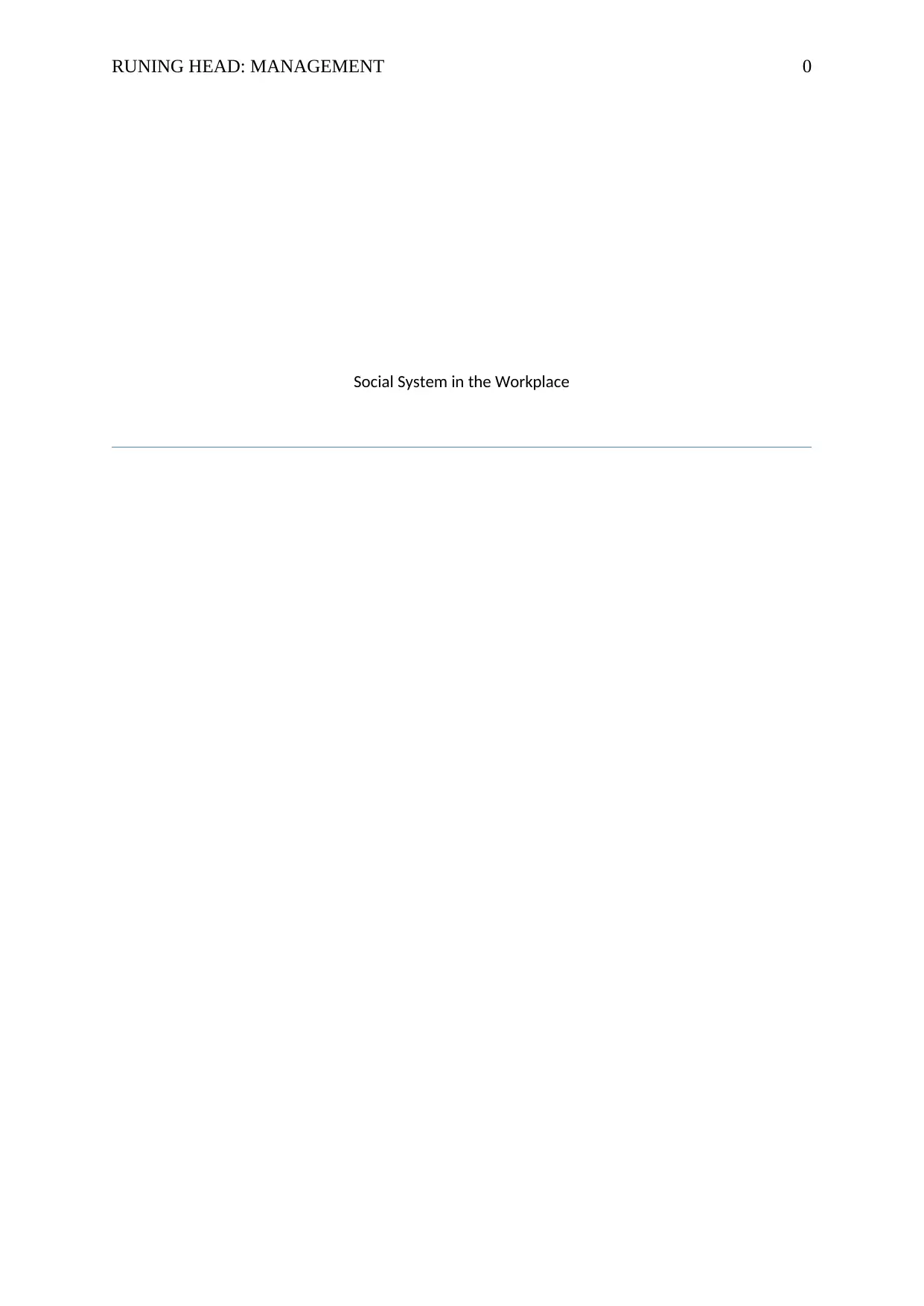
RUNING HEAD: MANAGEMENT 0
Social System in the Workplace
Social System in the Workplace
Paraphrase This Document
Need a fresh take? Get an instant paraphrase of this document with our AI Paraphraser
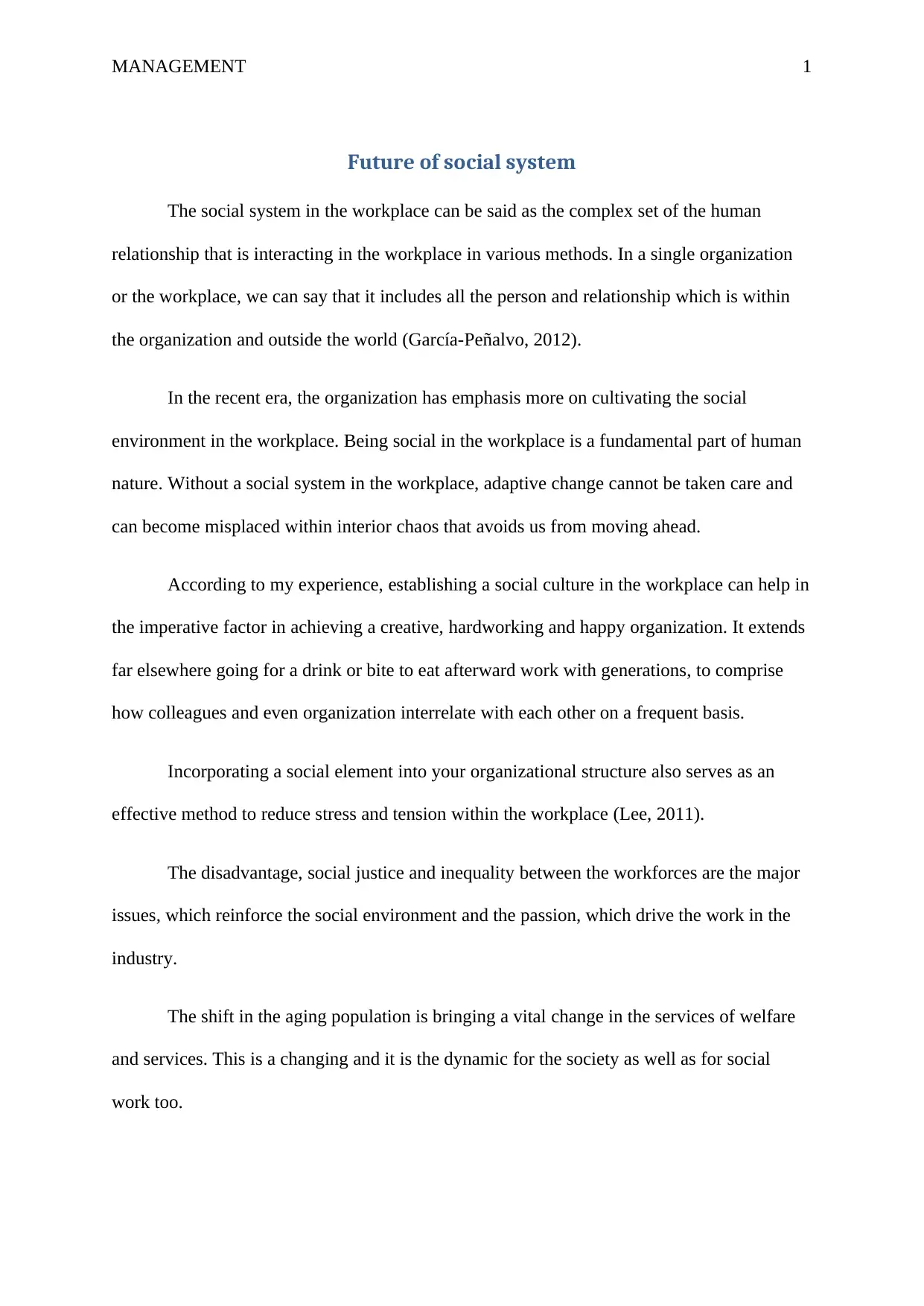
MANAGEMENT 1
Future of social system
The social system in the workplace can be said as the complex set of the human
relationship that is interacting in the workplace in various methods. In a single organization
or the workplace, we can say that it includes all the person and relationship which is within
the organization and outside the world (García-Peñalvo, 2012).
In the recent era, the organization has emphasis more on cultivating the social
environment in the workplace. Being social in the workplace is a fundamental part of human
nature. Without a social system in the workplace, adaptive change cannot be taken care and
can become misplaced within interior chaos that avoids us from moving ahead.
According to my experience, establishing a social culture in the workplace can help in
the imperative factor in achieving a creative, hardworking and happy organization. It extends
far elsewhere going for a drink or bite to eat afterward work with generations, to comprise
how colleagues and even organization interrelate with each other on a frequent basis.
Incorporating a social element into your organizational structure also serves as an
effective method to reduce stress and tension within the workplace (Lee, 2011).
The disadvantage, social justice and inequality between the workforces are the major
issues, which reinforce the social environment and the passion, which drive the work in the
industry.
The shift in the aging population is bringing a vital change in the services of welfare
and services. This is a changing and it is the dynamic for the society as well as for social
work too.
Future of social system
The social system in the workplace can be said as the complex set of the human
relationship that is interacting in the workplace in various methods. In a single organization
or the workplace, we can say that it includes all the person and relationship which is within
the organization and outside the world (García-Peñalvo, 2012).
In the recent era, the organization has emphasis more on cultivating the social
environment in the workplace. Being social in the workplace is a fundamental part of human
nature. Without a social system in the workplace, adaptive change cannot be taken care and
can become misplaced within interior chaos that avoids us from moving ahead.
According to my experience, establishing a social culture in the workplace can help in
the imperative factor in achieving a creative, hardworking and happy organization. It extends
far elsewhere going for a drink or bite to eat afterward work with generations, to comprise
how colleagues and even organization interrelate with each other on a frequent basis.
Incorporating a social element into your organizational structure also serves as an
effective method to reduce stress and tension within the workplace (Lee, 2011).
The disadvantage, social justice and inequality between the workforces are the major
issues, which reinforce the social environment and the passion, which drive the work in the
industry.
The shift in the aging population is bringing a vital change in the services of welfare
and services. This is a changing and it is the dynamic for the society as well as for social
work too.
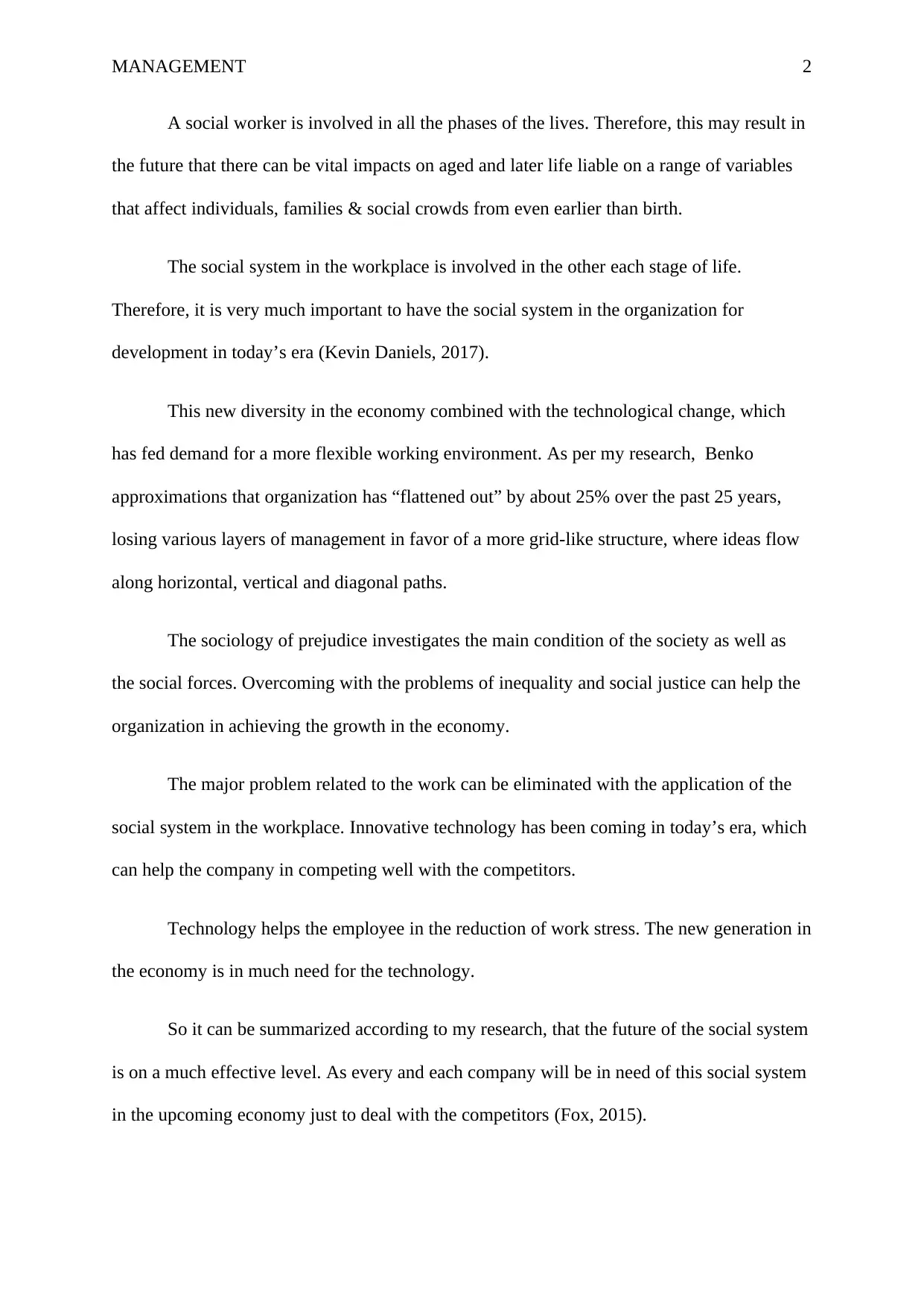
MANAGEMENT 2
A social worker is involved in all the phases of the lives. Therefore, this may result in
the future that there can be vital impacts on aged and later life liable on a range of variables
that affect individuals, families & social crowds from even earlier than birth.
The social system in the workplace is involved in the other each stage of life.
Therefore, it is very much important to have the social system in the organization for
development in today’s era (Kevin Daniels, 2017).
This new diversity in the economy combined with the technological change, which
has fed demand for a more flexible working environment. As per my research, Benko
approximations that organization has “flattened out” by about 25% over the past 25 years,
losing various layers of management in favor of a more grid-like structure, where ideas flow
along horizontal, vertical and diagonal paths.
The sociology of prejudice investigates the main condition of the society as well as
the social forces. Overcoming with the problems of inequality and social justice can help the
organization in achieving the growth in the economy.
The major problem related to the work can be eliminated with the application of the
social system in the workplace. Innovative technology has been coming in today’s era, which
can help the company in competing well with the competitors.
Technology helps the employee in the reduction of work stress. The new generation in
the economy is in much need for the technology.
So it can be summarized according to my research, that the future of the social system
is on a much effective level. As every and each company will be in need of this social system
in the upcoming economy just to deal with the competitors (Fox, 2015).
A social worker is involved in all the phases of the lives. Therefore, this may result in
the future that there can be vital impacts on aged and later life liable on a range of variables
that affect individuals, families & social crowds from even earlier than birth.
The social system in the workplace is involved in the other each stage of life.
Therefore, it is very much important to have the social system in the organization for
development in today’s era (Kevin Daniels, 2017).
This new diversity in the economy combined with the technological change, which
has fed demand for a more flexible working environment. As per my research, Benko
approximations that organization has “flattened out” by about 25% over the past 25 years,
losing various layers of management in favor of a more grid-like structure, where ideas flow
along horizontal, vertical and diagonal paths.
The sociology of prejudice investigates the main condition of the society as well as
the social forces. Overcoming with the problems of inequality and social justice can help the
organization in achieving the growth in the economy.
The major problem related to the work can be eliminated with the application of the
social system in the workplace. Innovative technology has been coming in today’s era, which
can help the company in competing well with the competitors.
Technology helps the employee in the reduction of work stress. The new generation in
the economy is in much need for the technology.
So it can be summarized according to my research, that the future of the social system
is on a much effective level. As every and each company will be in need of this social system
in the upcoming economy just to deal with the competitors (Fox, 2015).
⊘ This is a preview!⊘
Do you want full access?
Subscribe today to unlock all pages.

Trusted by 1+ million students worldwide
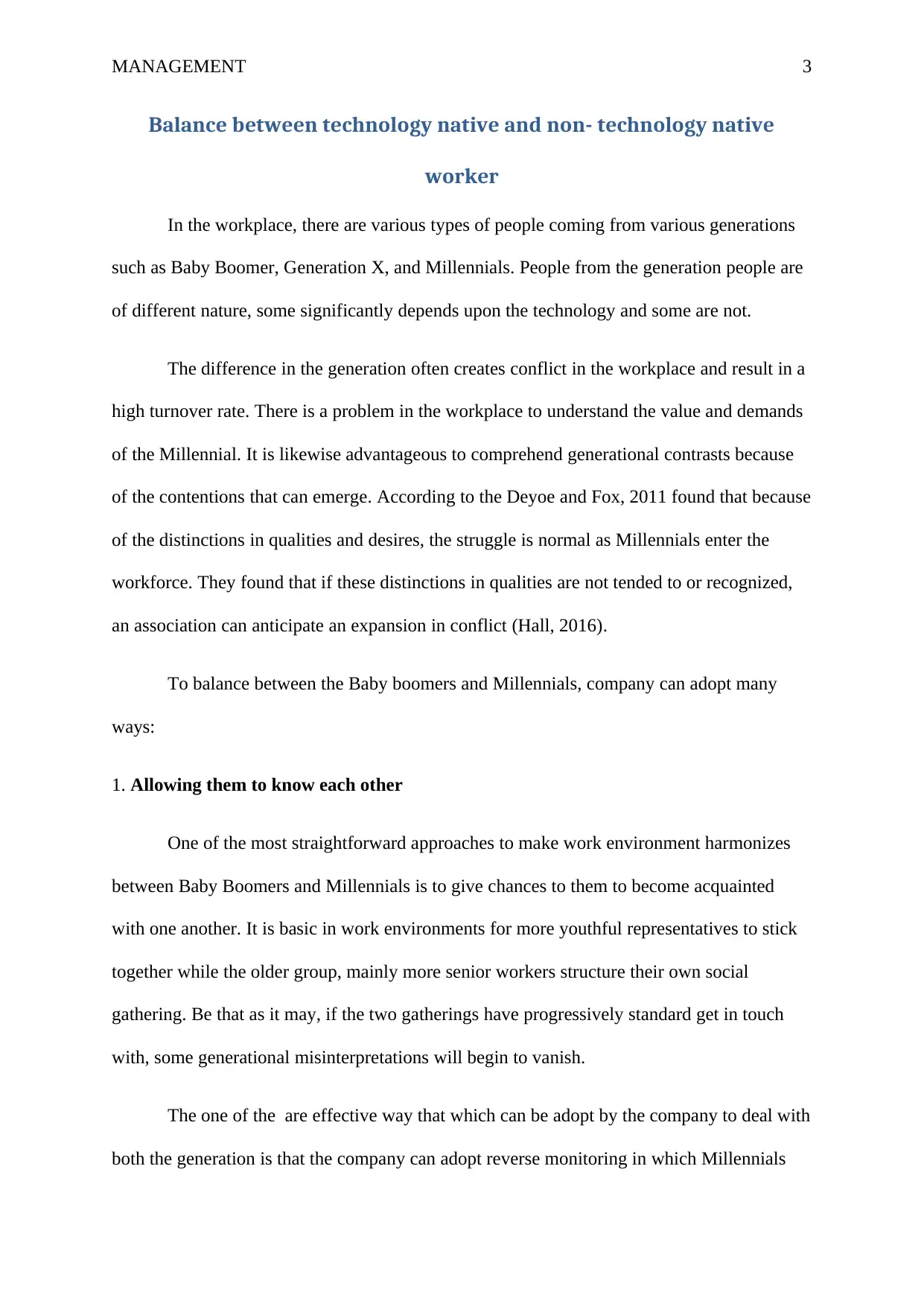
MANAGEMENT 3
Balance between technology native and non- technology native
worker
In the workplace, there are various types of people coming from various generations
such as Baby Boomer, Generation X, and Millennials. People from the generation people are
of different nature, some significantly depends upon the technology and some are not.
The difference in the generation often creates conflict in the workplace and result in a
high turnover rate. There is a problem in the workplace to understand the value and demands
of the Millennial. It is likewise advantageous to comprehend generational contrasts because
of the contentions that can emerge. According to the Deyoe and Fox, 2011 found that because
of the distinctions in qualities and desires, the struggle is normal as Millennials enter the
workforce. They found that if these distinctions in qualities are not tended to or recognized,
an association can anticipate an expansion in conflict (Hall, 2016).
To balance between the Baby boomers and Millennials, company can adopt many
ways:
1. Allowing them to know each other
One of the most straightforward approaches to make work environment harmonizes
between Baby Boomers and Millennials is to give chances to them to become acquainted
with one another. It is basic in work environments for more youthful representatives to stick
together while the older group, mainly more senior workers structure their own social
gathering. Be that as it may, if the two gatherings have progressively standard get in touch
with, some generational misinterpretations will begin to vanish.
The one of the are effective way that which can be adopt by the company to deal with
both the generation is that the company can adopt reverse monitoring in which Millennials
Balance between technology native and non- technology native
worker
In the workplace, there are various types of people coming from various generations
such as Baby Boomer, Generation X, and Millennials. People from the generation people are
of different nature, some significantly depends upon the technology and some are not.
The difference in the generation often creates conflict in the workplace and result in a
high turnover rate. There is a problem in the workplace to understand the value and demands
of the Millennial. It is likewise advantageous to comprehend generational contrasts because
of the contentions that can emerge. According to the Deyoe and Fox, 2011 found that because
of the distinctions in qualities and desires, the struggle is normal as Millennials enter the
workforce. They found that if these distinctions in qualities are not tended to or recognized,
an association can anticipate an expansion in conflict (Hall, 2016).
To balance between the Baby boomers and Millennials, company can adopt many
ways:
1. Allowing them to know each other
One of the most straightforward approaches to make work environment harmonizes
between Baby Boomers and Millennials is to give chances to them to become acquainted
with one another. It is basic in work environments for more youthful representatives to stick
together while the older group, mainly more senior workers structure their own social
gathering. Be that as it may, if the two gatherings have progressively standard get in touch
with, some generational misinterpretations will begin to vanish.
The one of the are effective way that which can be adopt by the company to deal with
both the generation is that the company can adopt reverse monitoring in which Millennials
Paraphrase This Document
Need a fresh take? Get an instant paraphrase of this document with our AI Paraphraser
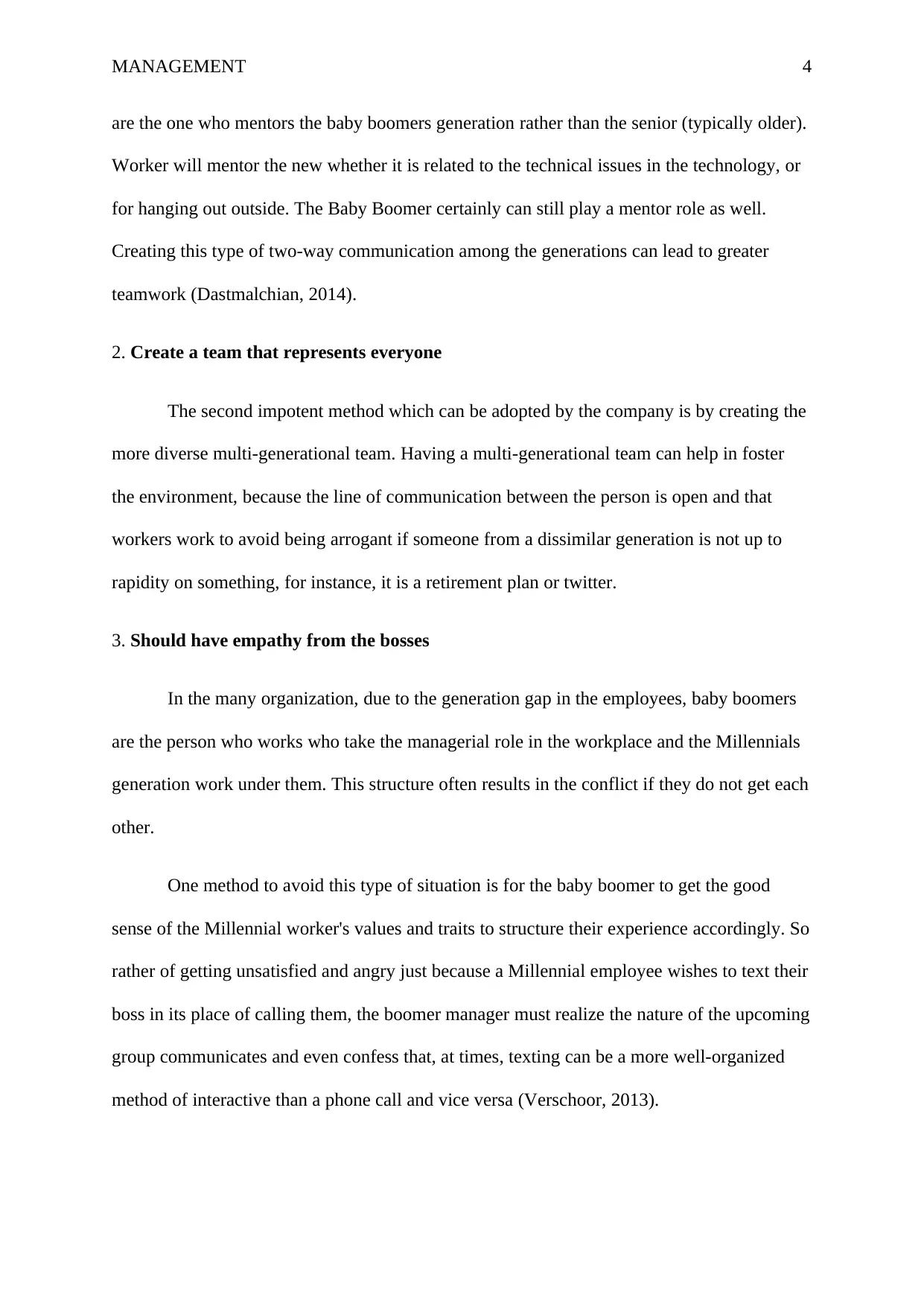
MANAGEMENT 4
are the one who mentors the baby boomers generation rather than the senior (typically older).
Worker will mentor the new whether it is related to the technical issues in the technology, or
for hanging out outside. The Baby Boomer certainly can still play a mentor role as well.
Creating this type of two-way communication among the generations can lead to greater
teamwork (Dastmalchian, 2014).
2. Create a team that represents everyone
The second impotent method which can be adopted by the company is by creating the
more diverse multi-generational team. Having a multi-generational team can help in foster
the environment, because the line of communication between the person is open and that
workers work to avoid being arrogant if someone from a dissimilar generation is not up to
rapidity on something, for instance, it is a retirement plan or twitter.
3. Should have empathy from the bosses
In the many organization, due to the generation gap in the employees, baby boomers
are the person who works who take the managerial role in the workplace and the Millennials
generation work under them. This structure often results in the conflict if they do not get each
other.
One method to avoid this type of situation is for the baby boomer to get the good
sense of the Millennial worker's values and traits to structure their experience accordingly. So
rather of getting unsatisfied and angry just because a Millennial employee wishes to text their
boss in its place of calling them, the boomer manager must realize the nature of the upcoming
group communicates and even confess that, at times, texting can be a more well-organized
method of interactive than a phone call and vice versa (Verschoor, 2013).
are the one who mentors the baby boomers generation rather than the senior (typically older).
Worker will mentor the new whether it is related to the technical issues in the technology, or
for hanging out outside. The Baby Boomer certainly can still play a mentor role as well.
Creating this type of two-way communication among the generations can lead to greater
teamwork (Dastmalchian, 2014).
2. Create a team that represents everyone
The second impotent method which can be adopted by the company is by creating the
more diverse multi-generational team. Having a multi-generational team can help in foster
the environment, because the line of communication between the person is open and that
workers work to avoid being arrogant if someone from a dissimilar generation is not up to
rapidity on something, for instance, it is a retirement plan or twitter.
3. Should have empathy from the bosses
In the many organization, due to the generation gap in the employees, baby boomers
are the person who works who take the managerial role in the workplace and the Millennials
generation work under them. This structure often results in the conflict if they do not get each
other.
One method to avoid this type of situation is for the baby boomer to get the good
sense of the Millennial worker's values and traits to structure their experience accordingly. So
rather of getting unsatisfied and angry just because a Millennial employee wishes to text their
boss in its place of calling them, the boomer manager must realize the nature of the upcoming
group communicates and even confess that, at times, texting can be a more well-organized
method of interactive than a phone call and vice versa (Verschoor, 2013).
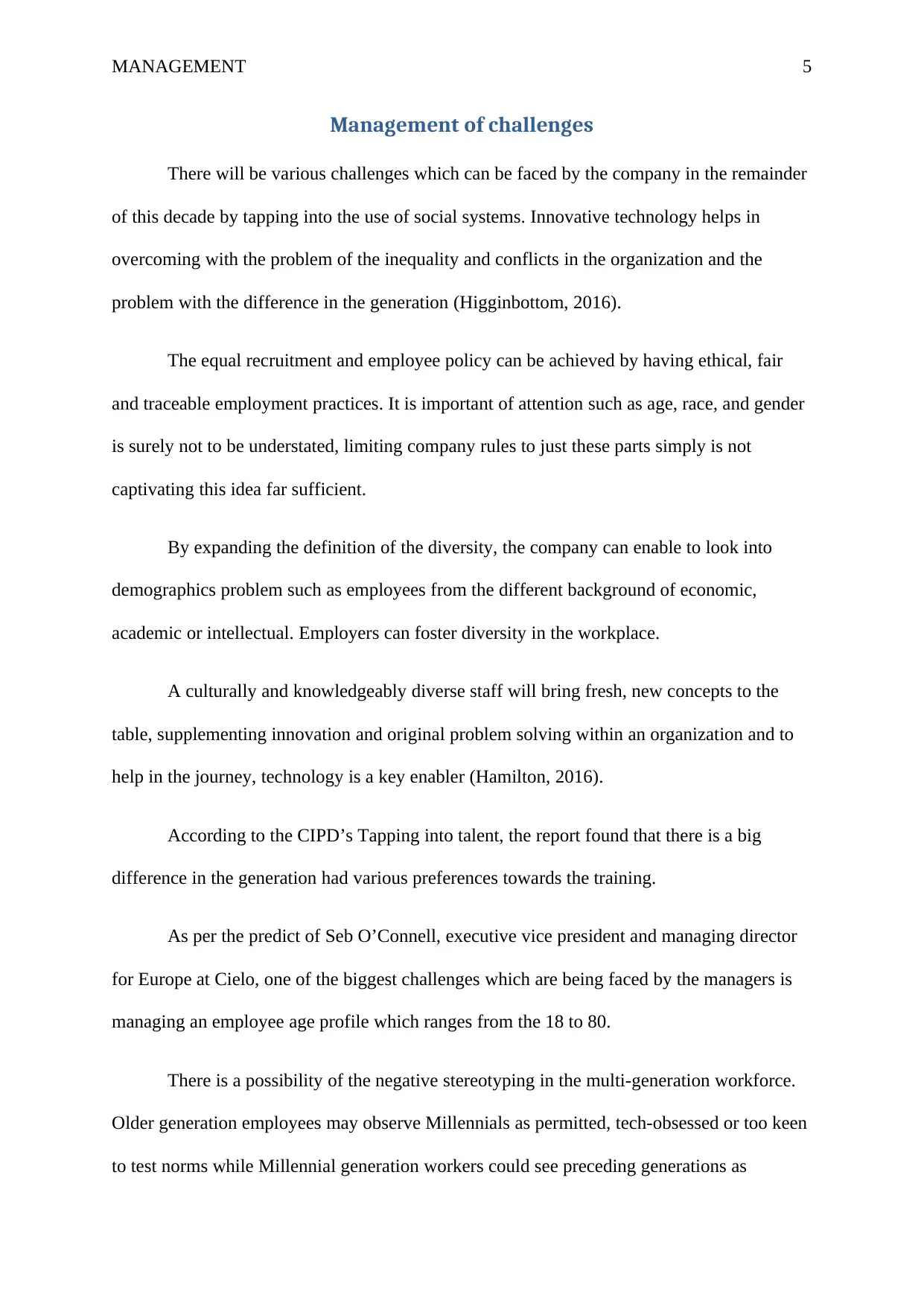
MANAGEMENT 5
Management of challenges
There will be various challenges which can be faced by the company in the remainder
of this decade by tapping into the use of social systems. Innovative technology helps in
overcoming with the problem of the inequality and conflicts in the organization and the
problem with the difference in the generation (Higginbottom, 2016).
The equal recruitment and employee policy can be achieved by having ethical, fair
and traceable employment practices. It is important of attention such as age, race, and gender
is surely not to be understated, limiting company rules to just these parts simply is not
captivating this idea far sufficient.
By expanding the definition of the diversity, the company can enable to look into
demographics problem such as employees from the different background of economic,
academic or intellectual. Employers can foster diversity in the workplace.
A culturally and knowledgeably diverse staff will bring fresh, new concepts to the
table, supplementing innovation and original problem solving within an organization and to
help in the journey, technology is a key enabler (Hamilton, 2016).
According to the CIPD’s Tapping into talent, the report found that there is a big
difference in the generation had various preferences towards the training.
As per the predict of Seb O’Connell, executive vice president and managing director
for Europe at Cielo, one of the biggest challenges which are being faced by the managers is
managing an employee age profile which ranges from the 18 to 80.
There is a possibility of the negative stereotyping in the multi-generation workforce.
Older generation employees may observe Millennials as permitted, tech-obsessed or too keen
to test norms while Millennial generation workers could see preceding generations as
Management of challenges
There will be various challenges which can be faced by the company in the remainder
of this decade by tapping into the use of social systems. Innovative technology helps in
overcoming with the problem of the inequality and conflicts in the organization and the
problem with the difference in the generation (Higginbottom, 2016).
The equal recruitment and employee policy can be achieved by having ethical, fair
and traceable employment practices. It is important of attention such as age, race, and gender
is surely not to be understated, limiting company rules to just these parts simply is not
captivating this idea far sufficient.
By expanding the definition of the diversity, the company can enable to look into
demographics problem such as employees from the different background of economic,
academic or intellectual. Employers can foster diversity in the workplace.
A culturally and knowledgeably diverse staff will bring fresh, new concepts to the
table, supplementing innovation and original problem solving within an organization and to
help in the journey, technology is a key enabler (Hamilton, 2016).
According to the CIPD’s Tapping into talent, the report found that there is a big
difference in the generation had various preferences towards the training.
As per the predict of Seb O’Connell, executive vice president and managing director
for Europe at Cielo, one of the biggest challenges which are being faced by the managers is
managing an employee age profile which ranges from the 18 to 80.
There is a possibility of the negative stereotyping in the multi-generation workforce.
Older generation employees may observe Millennials as permitted, tech-obsessed or too keen
to test norms while Millennial generation workers could see preceding generations as
⊘ This is a preview!⊘
Do you want full access?
Subscribe today to unlock all pages.

Trusted by 1+ million students worldwide
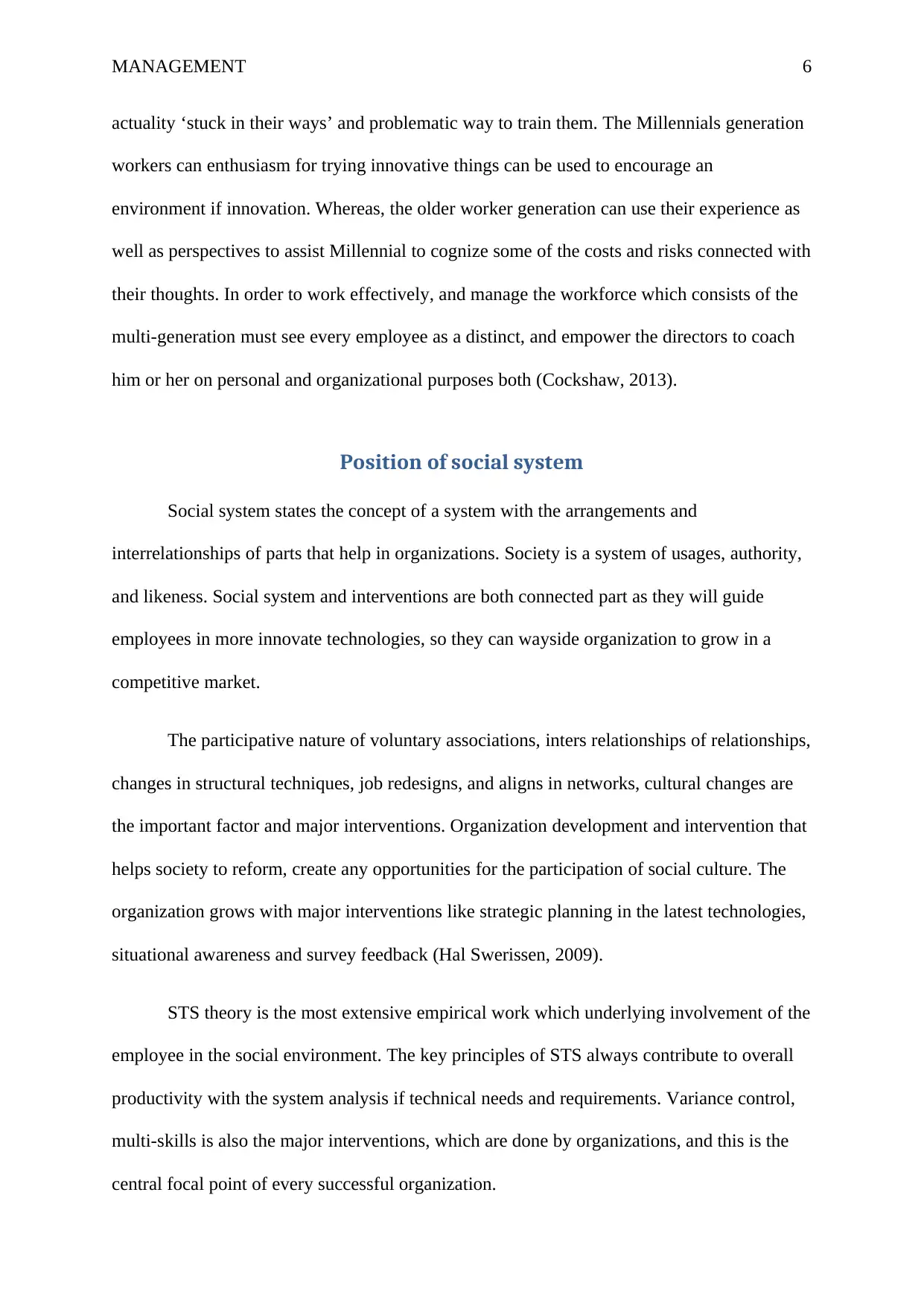
MANAGEMENT 6
actuality ‘stuck in their ways’ and problematic way to train them. The Millennials generation
workers can enthusiasm for trying innovative things can be used to encourage an
environment if innovation. Whereas, the older worker generation can use their experience as
well as perspectives to assist Millennial to cognize some of the costs and risks connected with
their thoughts. In order to work effectively, and manage the workforce which consists of the
multi-generation must see every employee as a distinct, and empower the directors to coach
him or her on personal and organizational purposes both (Cockshaw, 2013).
Position of social system
Social system states the concept of a system with the arrangements and
interrelationships of parts that help in organizations. Society is a system of usages, authority,
and likeness. Social system and interventions are both connected part as they will guide
employees in more innovate technologies, so they can wayside organization to grow in a
competitive market.
The participative nature of voluntary associations, inters relationships of relationships,
changes in structural techniques, job redesigns, and aligns in networks, cultural changes are
the important factor and major interventions. Organization development and intervention that
helps society to reform, create any opportunities for the participation of social culture. The
organization grows with major interventions like strategic planning in the latest technologies,
situational awareness and survey feedback (Hal Swerissen, 2009).
STS theory is the most extensive empirical work which underlying involvement of the
employee in the social environment. The key principles of STS always contribute to overall
productivity with the system analysis if technical needs and requirements. Variance control,
multi-skills is also the major interventions, which are done by organizations, and this is the
central focal point of every successful organization.
actuality ‘stuck in their ways’ and problematic way to train them. The Millennials generation
workers can enthusiasm for trying innovative things can be used to encourage an
environment if innovation. Whereas, the older worker generation can use their experience as
well as perspectives to assist Millennial to cognize some of the costs and risks connected with
their thoughts. In order to work effectively, and manage the workforce which consists of the
multi-generation must see every employee as a distinct, and empower the directors to coach
him or her on personal and organizational purposes both (Cockshaw, 2013).
Position of social system
Social system states the concept of a system with the arrangements and
interrelationships of parts that help in organizations. Society is a system of usages, authority,
and likeness. Social system and interventions are both connected part as they will guide
employees in more innovate technologies, so they can wayside organization to grow in a
competitive market.
The participative nature of voluntary associations, inters relationships of relationships,
changes in structural techniques, job redesigns, and aligns in networks, cultural changes are
the important factor and major interventions. Organization development and intervention that
helps society to reform, create any opportunities for the participation of social culture. The
organization grows with major interventions like strategic planning in the latest technologies,
situational awareness and survey feedback (Hal Swerissen, 2009).
STS theory is the most extensive empirical work which underlying involvement of the
employee in the social environment. The key principles of STS always contribute to overall
productivity with the system analysis if technical needs and requirements. Variance control,
multi-skills is also the major interventions, which are done by organizations, and this is the
central focal point of every successful organization.
Paraphrase This Document
Need a fresh take? Get an instant paraphrase of this document with our AI Paraphraser
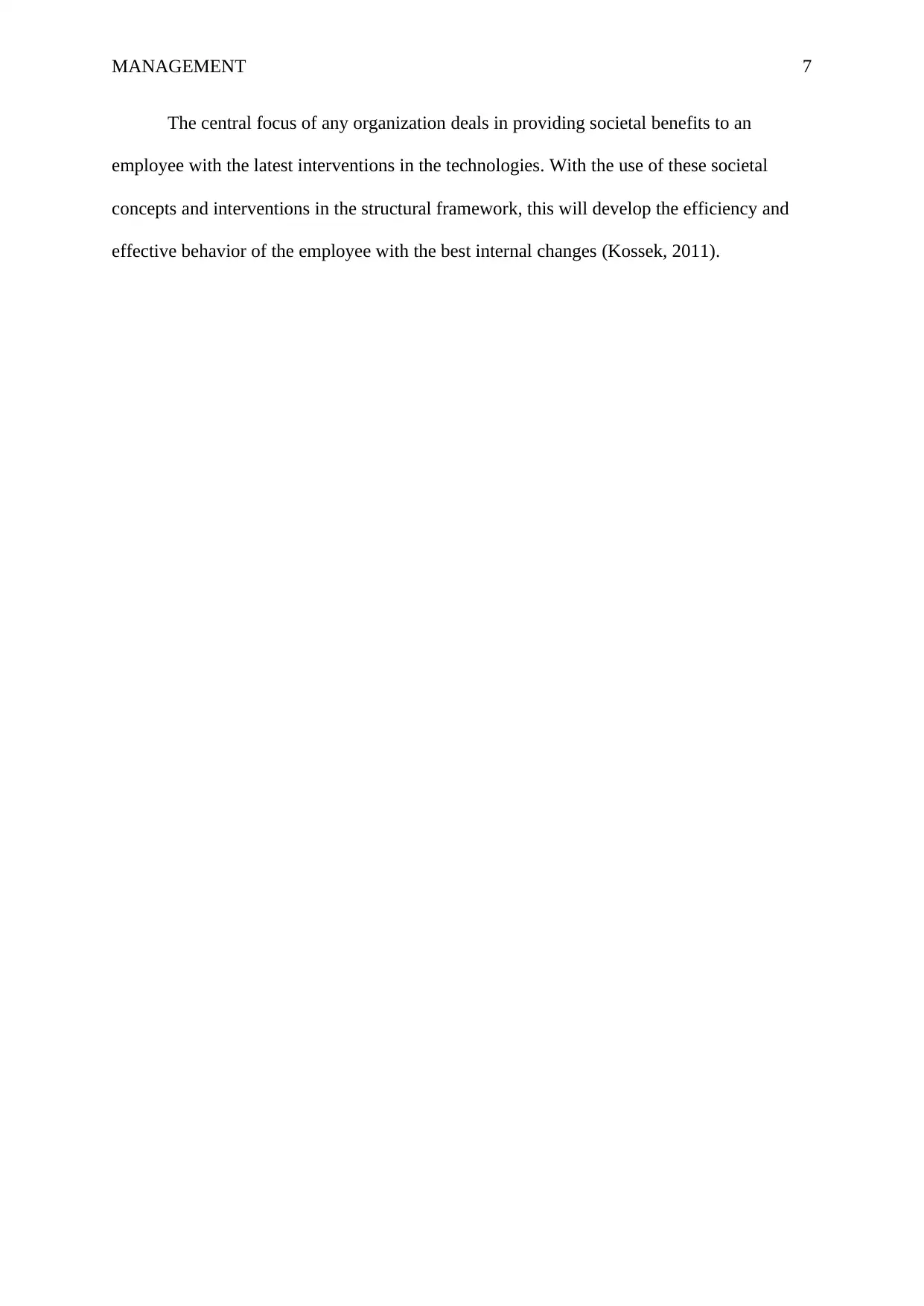
MANAGEMENT 7
The central focus of any organization deals in providing societal benefits to an
employee with the latest interventions in the technologies. With the use of these societal
concepts and interventions in the structural framework, this will develop the efficiency and
effective behavior of the employee with the best internal changes (Kossek, 2011).
The central focus of any organization deals in providing societal benefits to an
employee with the latest interventions in the technologies. With the use of these societal
concepts and interventions in the structural framework, this will develop the efficiency and
effective behavior of the employee with the best internal changes (Kossek, 2011).
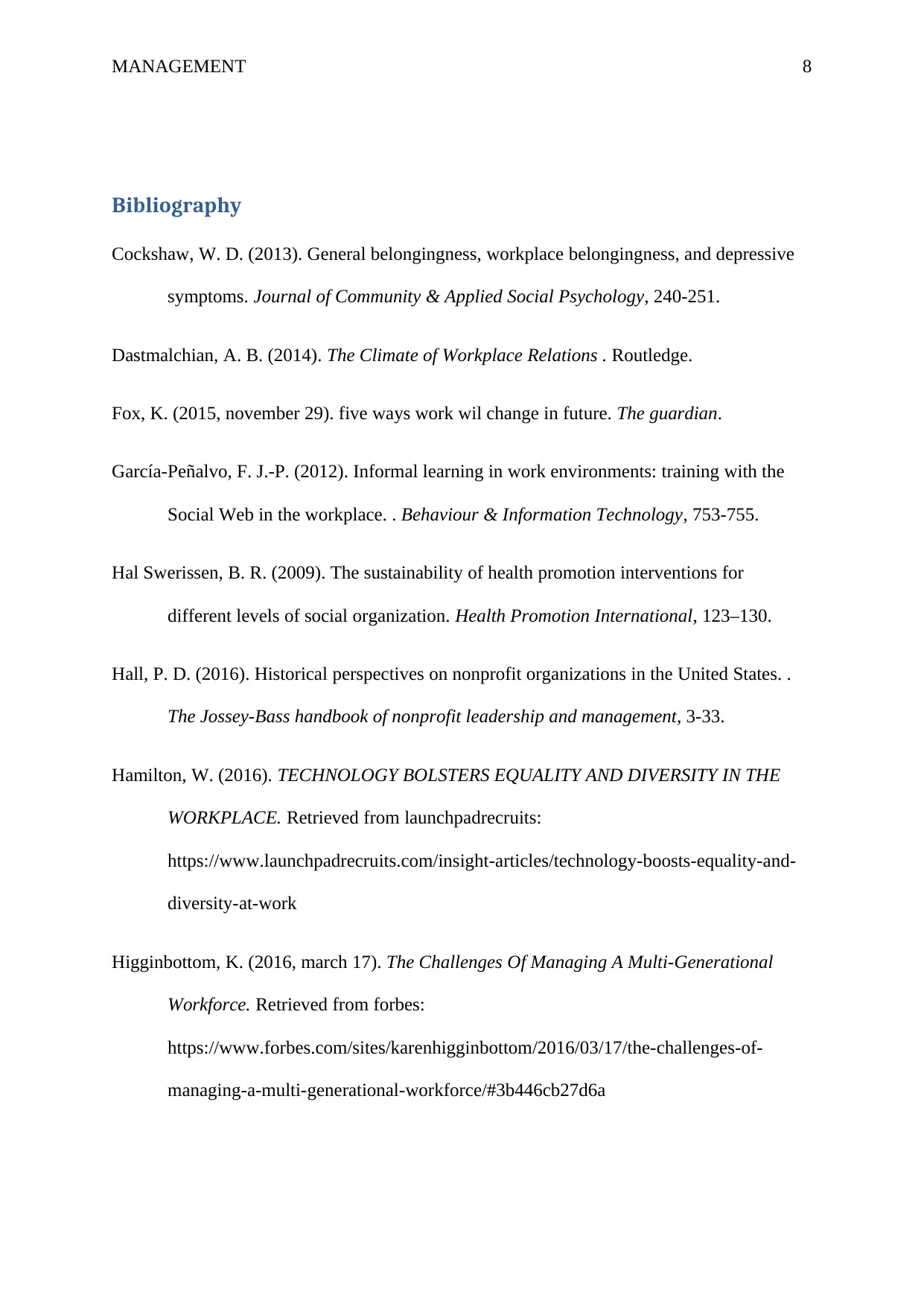
MANAGEMENT 8
Bibliography
Cockshaw, W. D. (2013). General belongingness, workplace belongingness, and depressive
symptoms. Journal of Community & Applied Social Psychology, 240-251.
Dastmalchian, A. B. (2014). The Climate of Workplace Relations . Routledge.
Fox, K. (2015, november 29). five ways work wil change in future. The guardian.
García-Peñalvo, F. J.-P. (2012). Informal learning in work environments: training with the
Social Web in the workplace. . Behaviour & Information Technology, 753-755.
Hal Swerissen, B. R. (2009). The sustainability of health promotion interventions for
different levels of social organization. Health Promotion International, 123–130.
Hall, P. D. (2016). Historical perspectives on nonprofit organizations in the United States. .
The Jossey-Bass handbook of nonprofit leadership and management, 3-33.
Hamilton, W. (2016). TECHNOLOGY BOLSTERS EQUALITY AND DIVERSITY IN THE
WORKPLACE. Retrieved from launchpadrecruits:
https://www.launchpadrecruits.com/insight-articles/technology-boosts-equality-and-
diversity-at-work
Higginbottom, K. (2016, march 17). The Challenges Of Managing A Multi-Generational
Workforce. Retrieved from forbes:
https://www.forbes.com/sites/karenhigginbottom/2016/03/17/the-challenges-of-
managing-a-multi-generational-workforce/#3b446cb27d6a
Bibliography
Cockshaw, W. D. (2013). General belongingness, workplace belongingness, and depressive
symptoms. Journal of Community & Applied Social Psychology, 240-251.
Dastmalchian, A. B. (2014). The Climate of Workplace Relations . Routledge.
Fox, K. (2015, november 29). five ways work wil change in future. The guardian.
García-Peñalvo, F. J.-P. (2012). Informal learning in work environments: training with the
Social Web in the workplace. . Behaviour & Information Technology, 753-755.
Hal Swerissen, B. R. (2009). The sustainability of health promotion interventions for
different levels of social organization. Health Promotion International, 123–130.
Hall, P. D. (2016). Historical perspectives on nonprofit organizations in the United States. .
The Jossey-Bass handbook of nonprofit leadership and management, 3-33.
Hamilton, W. (2016). TECHNOLOGY BOLSTERS EQUALITY AND DIVERSITY IN THE
WORKPLACE. Retrieved from launchpadrecruits:
https://www.launchpadrecruits.com/insight-articles/technology-boosts-equality-and-
diversity-at-work
Higginbottom, K. (2016, march 17). The Challenges Of Managing A Multi-Generational
Workforce. Retrieved from forbes:
https://www.forbes.com/sites/karenhigginbottom/2016/03/17/the-challenges-of-
managing-a-multi-generational-workforce/#3b446cb27d6a
⊘ This is a preview!⊘
Do you want full access?
Subscribe today to unlock all pages.

Trusted by 1+ million students worldwide
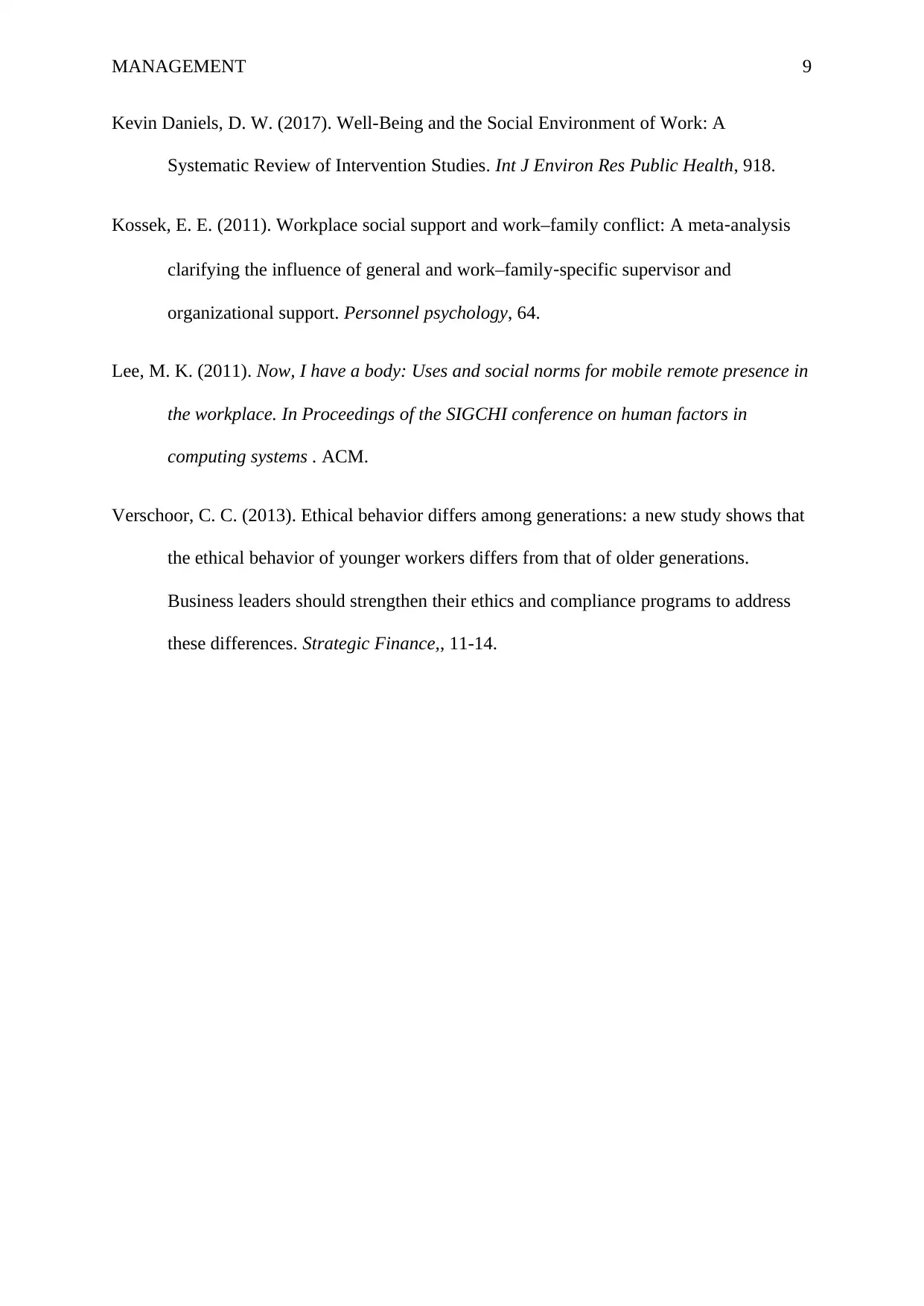
MANAGEMENT 9
Kevin Daniels, D. W. (2017). Well-Being and the Social Environment of Work: A
Systematic Review of Intervention Studies. Int J Environ Res Public Health, 918.
Kossek, E. E. (2011). Workplace social support and work–family conflict: A meta‐analysis
clarifying the influence of general and work–family‐specific supervisor and
organizational support. Personnel psychology, 64.
Lee, M. K. (2011). Now, I have a body: Uses and social norms for mobile remote presence in
the workplace. In Proceedings of the SIGCHI conference on human factors in
computing systems . ACM.
Verschoor, C. C. (2013). Ethical behavior differs among generations: a new study shows that
the ethical behavior of younger workers differs from that of older generations.
Business leaders should strengthen their ethics and compliance programs to address
these differences. Strategic Finance,, 11-14.
Kevin Daniels, D. W. (2017). Well-Being and the Social Environment of Work: A
Systematic Review of Intervention Studies. Int J Environ Res Public Health, 918.
Kossek, E. E. (2011). Workplace social support and work–family conflict: A meta‐analysis
clarifying the influence of general and work–family‐specific supervisor and
organizational support. Personnel psychology, 64.
Lee, M. K. (2011). Now, I have a body: Uses and social norms for mobile remote presence in
the workplace. In Proceedings of the SIGCHI conference on human factors in
computing systems . ACM.
Verschoor, C. C. (2013). Ethical behavior differs among generations: a new study shows that
the ethical behavior of younger workers differs from that of older generations.
Business leaders should strengthen their ethics and compliance programs to address
these differences. Strategic Finance,, 11-14.
1 out of 10
Related Documents
Your All-in-One AI-Powered Toolkit for Academic Success.
+13062052269
info@desklib.com
Available 24*7 on WhatsApp / Email
![[object Object]](/_next/static/media/star-bottom.7253800d.svg)
Unlock your academic potential
Copyright © 2020–2025 A2Z Services. All Rights Reserved. Developed and managed by ZUCOL.





